
Back Bhakti-beweging Afrikaans الحركة البهاكتية Arabic الحركه البهاكتيه ARZ ভক্তি আন্দোলন Bengali/Bangla Movimiento Bhakti Spanish جنبش بهکتی Persian בהקטי HE भक्ति आन्दोलन Hindi Gerakan Bhakti ID Movimento Bhakti Italian
| Part of a series on |
| Hinduism |
|---|
 |
| Part of a series on |
| Hinduism in India |
|---|
| Part of a series on |
| Sikhism |
|---|
 |

The Bhakti movement was a significant religious movement in medieval Hinduism[1] that sought to bring religious reforms to all strata of society by adopting the method of devotion to achieve salvation.[2] Originating in Tamilakam during 6th century CE,[3][4][5][6] it gained prominence through the poems and teachings of the Vaishnava Alvars and Shaiva Nayanars before spreading northwards.[1] It swept over east and north India from the 15th century onwards, reaching its zenith between the 15th and 17th century CE.[7]
The Bhakti movement regionally developed around different gods and goddesses, and some sub-sects were Vaishnavism (Vishnu), Shaivism (Shiva), Shaktism (Shakti goddesses), and Smartism.[8][9][10] The Bhakti movement preached using the local languages so that the message reached the masses. The movement was inspired by many poet-saints, who championed a wide range of philosophical positions ranging from theistic dualism of Dvaita to absolute monism of Advaita Vedanta.[11][12]
The movement has traditionally been considered an influential social reformation in Hinduism in that it provided an individual-focused alternative path to spirituality regardless of one's birth or gender.[7] Contemporary scholars question whether the Bhakti movement ever was a reform or rebellion of any kind.[13] They suggest the Bhakti movement was a revival, reworking and recontextualisation of ancient Vedic traditions.[14]
- ^ a b Schomer & McLeod (1987), p. 1.
- ^ India Today Web Desk New (24 January 2019). "CBSE Class 12 History #CrashCourse: Bhakti movement's emergence and influence". India Today.
- ^ Pillai, P. Govinda (4 October 2022). "Chapter 11". The Bhakti Movement: Renaissance or Revivalism?. Taylor & Francis. pp. Thirdly, the movement had blossomed first down south or the Tamil country. ISBN 978-1-000-78039-0.
- ^ Hawley 2015, p. 87.
- ^ Padmaja, T. (2002). Temples of Kr̥ṣṇa in South India: History, Art, and Traditions in Tamil nāḍu. Abhinav Publications. ISBN 978-81-7017-398-4.
- ^ Nair, Rukmini Bhaya; de Souza, Peter Ronald (20 February 2020). Keywords for India: A Conceptual Lexicon for the 21st Century. Bloomsbury Publishing. ISBN 978-1-350-03925-4.
- ^ a b Schomer & McLeod (1987), pp. 1–2.
- ^ Lance Nelson (2007), An Introductory Dictionary of Theology and Religious Studies (Editors: Orlando O. Espín, James B. Nickoloff), Liturgical Press, ISBN 978-0814658567, pages 562-563
- ^ SS Kumar (2010), Bhakti – the Yoga of Love, LIT Verlag Münster, ISBN 978-3643501301, pages 35-36
- ^ Wendy Doniger (2009), "Bhakti", Encyclopædia BritannicaJohar, Surinder (1999). Guru Gobind Singh: A Multi-faceted Personality. MD Publications. p. 89. ISBN 978-8-175-33093-1.
- ^ Schomer & McLeod (1987), p. 2.
- ^ Christian Novetzke (2007). "Bhakti and Its Public". International Journal of Hindu Studies. 11 (3): 255–272. doi:10.1007/s11407-008-9049-9. JSTOR 25691067. S2CID 144065168.
- ^ Pechilis Prentiss (2014), pp. 10–16.
- ^ Pechilis Prentiss (2014), pp. 15–16.
